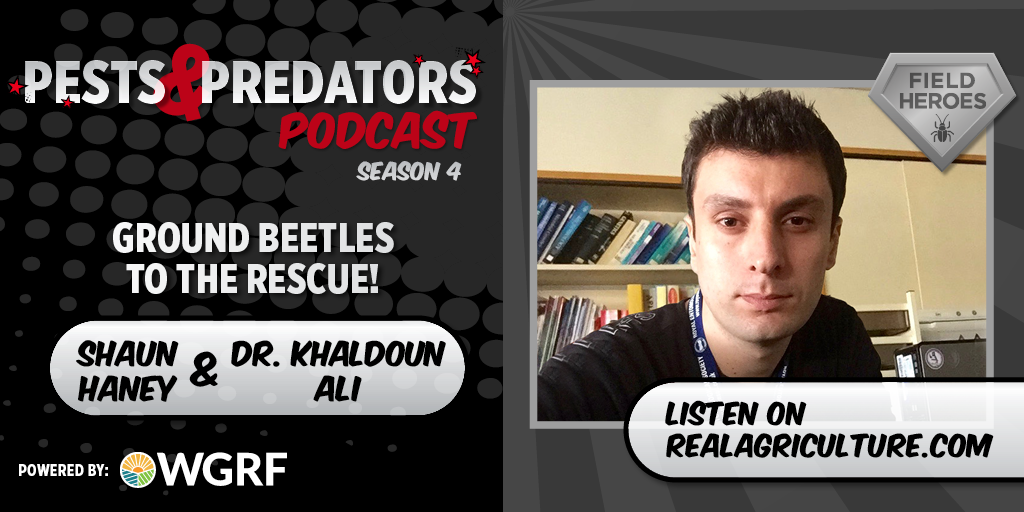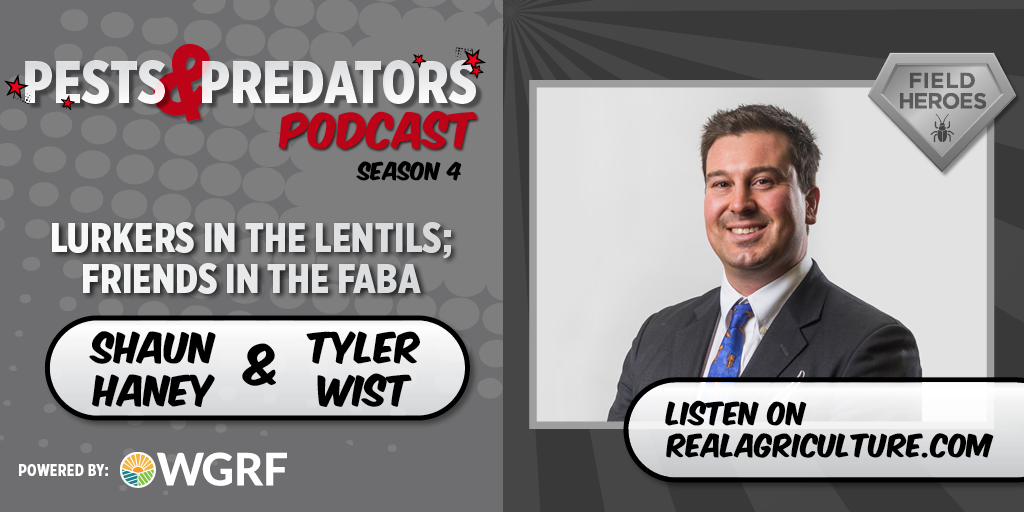
Sweep Net Video Series
Meghan Vankosky, Entomologist with Agriculture and Agri-Food Canada, breaks down sweep net technique in this how-to video series.
How to sweep a field
What’s in my sweep net?
Why use a sweep net?

Pests and Predators Podcast Series
Learn about the pests in your crops and the beneficial insects that prey on them!
Episode 27: Armoured Tanks: Beetles in Battle
Tyler Wist, Research Scientist, Field Crop Entomology, AAFC, SK, answers key questions about lady beetles, ground beetles and soft-winged flower beetles. Wist shares what these armoured tanks are doing in your field, if you should be concerned, and what you should do when you see them.
Episode 26: Invasive Species Awareness: Knowing what to look for and how to report it
Meghan Vankosky (Research Scientist, Field Crop Entomology, AAFC, Saskatoon), James Tansey (Entomologist, Saskatchewan Ministry of Agriculture) and John Gavloski (Entomologist, Manitoba Agriculture) join to highlight a program and regional posters created by the Insect Surveillance Community of Practice to enhance awareness of invasive species. They discuss some conspicuous species to watch out for in the Prairie Region and share insights on what people can do to help prevent the establishment and spread of invasive insects.
Episode 25: 20 years of canola surveying and counting!
Jennifer Otani, Insect Pest Management Scientist with Agriculture and Agri-Food Canada, shares insight on how long-term area-wide surveying is helping us understand the complexity of the canola canopy, and how producers can help researchers continue this vital research. Hear why 20 years isn’t enough, as researchers need to learn more, but it takes producer support!
Episode 24: Ground Beetles to the rescue!
Dr. Khaldoun Ali, Research Assistant & Lecturer at the University of Saskatchewan, explains the uniqueness of ground beetles and why they are classified as field heroes. As unique predators of pests and weed seeds, this episode breaks down the biology of ground beetles to help farmers identify these heroes, while also promoting ways to protect and encourage them in their own fields.
Episode 23: Wheat Stem Sawfly 101
Dylan Sjolie, Masters Student at the University of Saskatchewan, breaks down the fundamentals of wheat stem sawfly, its enemies and how to properly manage this insect. Have you wondered what wheat stem sawfly looks like, how and what it attacks, or the impact it can have? Dylan takes a deep dive into this pest’s biology while also sharing solutions to helping its natural enemies.
Episode 22: Biodiversity Benefits: On the farm & beyond!
Nevin Rosaasen, Sustainability & Government Relations Lead, Alberta Pulse Growers, discusses what biodiversity is and why it’s important for farmers to contribute. In this episode, he will take a deep dive into insect biodiversity in Western Canada, identify areas that could benefit from more research and provide insight as to how farmers should be thinking about biodiversity on their own farms.
Episode 21: Lurkers in the Lentils; Friends in the Faba
Tyler Wist, Research Scientist, Field Crop Entomology, AAFC, SK, will dive into the predation of pea aphids by beetles and flies, sharing the true villains and heroes of this story. Pea aphids are the villain and Tyler will share what sort of problems they can cause. But he’ll also share what farmers should know about the heroes (beetles and flies) when they go to control pea aphids in their lentils.
Episode 20: Prairie Pests and Predators: What can you expect?
John Gavloski, Manitoba Agriculture, James Tansey, Saskatchewan Ministry of Agriculture, and Shelley Barkley, Alberta Agriculture, join forces to share their field observations and provide Prairie insight on what to look for in 2023.You’ll hear a review of what pests and predators looked like in 2022 and what farmers should watch out for as they go to manage their pests this year.
Episode 19: Mapping Systems for Prairie Pest Protection
Meghan Vankosky, Research Scientist, Field Crop Entomology, AAFC, Saskatoon, explains how the Prairie Pest Monitoring Network is watching insect pest populations to support crop protection programs in the Prairies. She also shares insights on the insect surveillance programs and how farmers can use the maps and data to see pest forecasts and risk warnings.
Episode 18: Preying in the Canola Canopy
Jennifer Otani, Pest Management Biologist, AAFC, Beaverlodge, AB, showcases the roster of natural enemies that attack lygus nymphs in the canola canopy. Damselbugs, ladybird beetles, lacewing larvae and crab spiders gang up to battle this damaging canola pest. Otani shares how to protect this powerful team.
Episode 17: Spiders & their Amazing Appetites
Carol Frost, Assistant Professor of Conservation Biology at the University of Alberta, reveals some fascinating facts about spiders and the role they play in helping to control pest populations in crops. Learn how much they eat, how they intimidate their prey and why it’s important to adopt practices that improve spider biomasses in fields.
Episode 16: Parasitoids Prey on Pests in Pulses
Nevin Rosaasen, Policy & Program Specialist with Alberta Pulse Growers, shares scouting tips for pests and predators in pulse crops. He highlights the powerful parasitoid Banchus Flavescens as a natural enemy that attacks bertha armyworm. Rosaasen also describes other pests pulse growers should look out for and helps to define dynamic thresholds.
Episode 15: Aphid Milkshakes: Green Lacewing’s Fave
Tyler Wist, Research Scientist, Field Crop Entomology, AAFC, Saskatoon, SK, shines a spotlight on green lacewings. He provides all the gory details on how these beneficial insects devour their aphid prey. Wist also provides tips to protect green lacewings, which play a vital role in managing aphid populations.
Episode 14: Mistaken Identities: Insect Pest or Beneficial?
John Gavloski, Entomologist, Manitoba Agriculture, highlights some beneficial insects that are commonly misdiagnosed, including hover fly larvae, juvenile minute pirate bugs and stiletto fly larvae. Because growers and agronomists sometimes mistake beneficials for pests, Gavloski provides tips on how to distinguish and conserve them.
Episode 13: Weather Effects: Predicting Pest Populations
James Tansey, Entomologist, Saskatchewan Ministry of Agriculture and Meghan Vankosky, Research Scientist, Field Crop Entomology, AAFC, Saskatoon, explain the relationship between weather and pests. They talk about how natural enemies can help control pest populations, especially when pests and their predators respond similarly to changes in weather. If pests and predators have conflicting responses to weather conditions, then pest populations can ‘escape’ control by their natural enemies.
Episode 12: Get a Jump on Grasshoppers
James Tansey, Entomologist, Saskatchewan Ministry of Agriculture, discusses the types of grasshoppers that cause damage, the conditions they prefer, how to get ahead of them, and the beneficial insects that provide control.
Episode 11: Beneficial Insects Free Farm Labour
John Gavloski, Entomologist, Manitoba Agriculture and Resource Development, describes how beneficial insects contribute to farm profitability through services such as predation, parasitism, decomposition, pollination and weed seed consumption.
Episode 10: Good Bugs Relocate for Work
Héctor Cárcamo, Entomologist, AAFC, Lethbridge, AB, explains the strategic practice of introducing predatory insects to new regions to provide pest control. He shares examples of beneficial insects that have been relocated to Western Canada and what criteria is necessary to make the move.
Episode 9: Secret Agents in the Stubble
Jennifer Otani, Pest Management Biologist, AAFC, Beaverlodge, AB, shines a light on the mysterious secret agents lurking in crop stubble that attack wheat midge to defend crop yield and quality.
Episode 8: GOOD vs Pea Leaf WeEVIL
Meghan Vankosky, Research Scientist, Field Crop Entomology, AAFC, Saskatoon, SK, discusses the impact pea leaf weevils have on crops. She also shares best management practices, including scouting tips, and how beneficial insects can fight the weevil.
Episode 7: Powerful Parasitoids Better Than Fiction
Tyler Wist, Research Scientist, Field Crop Entomology, AAFC, Saskatoon, SK, gets in-depth on how Cotesia wasps parasitize wheat head armyworm, a damaging pest for cereal crops. As you’ll hear, the method of control sounds stranger than fiction.
Episode 6: Have Parasitoids Been Active in Your Fields?
Tyler Wist, Research Scientist, Field Crop Entomology, AAFC, Saskatoon, SK, explains what a parasitoid is and the function it serves in crops. Put simply, parasitoids are a specialized predator whose offspring will kill insect pests.
Episode 5: Keeping Wheat Stem Sawfly in Check
Scott Meers, Mayland Consulting, talks about the yield-robbing pest, wheat stem sawfly. He explains that one of its few controls is the Bracon sephi, an orange wasp that is less than a quarter inch long. He shares tips on how to protect this beneficial parasitoid.
Episode 4: Who’s After Grasshopper Eggs?
John Gavloski, Entomologist, Manitoba Agriculture and Resource Development, highlights four beneficial insects that help to control grasshopper populations by eating their eggs. He underscores the importance of protecting these egg eaters by choosing a more selective insecticide when pest thresholds are reached.
Episode 3: Cereal Leaf Beetles Be Gone
Haley Catton, Research Scientist, Cereal Crop Entomology, AAFC, Lethbridge, AB, talks about the importance of T. Julius as an effective means of cereal leaf beetle control. She says gaining knowledge about beneficial insects will help growers make more informed pest control decisions.
Episode 2: Prairie Pest Monitoring Network Survey Results
Meghan Vankosky, Research Scientist, Field Crop Entomology, AAFC, Saskatoon, SK, highlights the Prairie Pest Monitoring Network and the great resources available to support growers and agronomists. The network of entomologists creates annual pest forecast maps and provides weekly updates during the growing season.
Episode 1: Why Protect Beneficial Insects
Jennifer Otani, Pest Management Biologist, AAFC, Beaverlodge, AB, explains the important role beneficial insects play in agricultural systems. She showcases pollinators, predators and parasitoids and shares how their complex life cycles can control some of the most widespread economic pests.


















































